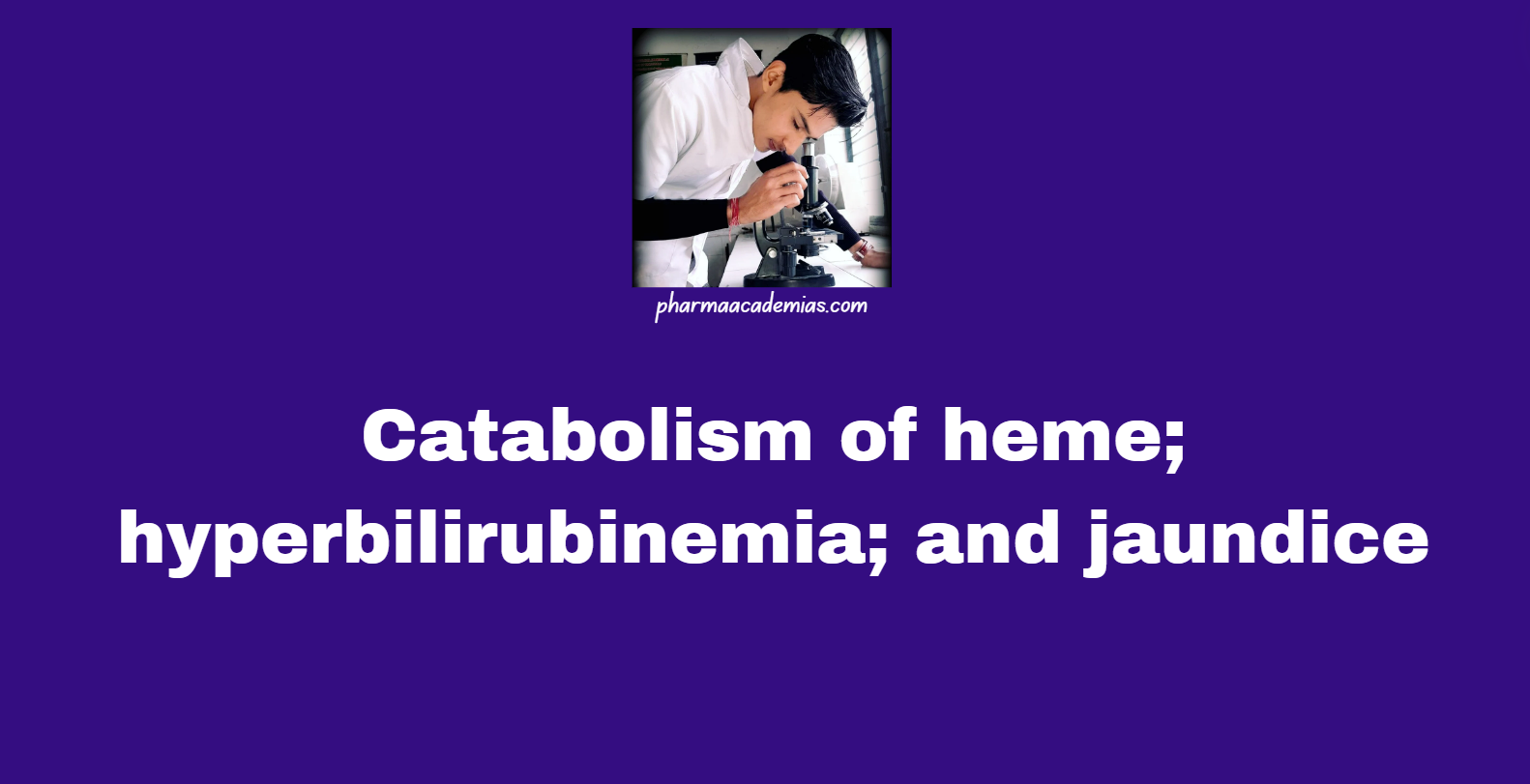Catabolism of Heme
Catabolism of Heme is a complex biological process that primarily occurs in the liver and spleen. This process is essential for the breakdown of heme, a component of hemoglobin, myoglobin, and various cytochromes. The steps involved in heme catabolism are as follows:
1. Heme Oxygenase Reaction:
Heme oxygenase (HO) is the enzyme responsible for the initial step of heme degradation.
HO catalyzes the oxidation of heme to biliverdin, iron (Fe2+), and carbon monoxide (CO).
This reaction requires oxygen and NADPH as cofactors.
There are two isoforms of heme oxygenase: HO-1 (inducible) and HO-2 (constitutive).
2. Biliverdin Reductase Reaction:
Biliverdin, a green pigment, is subsequently reduced to bilirubin, a yellow pigment, by the enzyme biliverdin reductase. This reaction also utilizes NADPH as a reducing agent.
3. Transport to Liver:
Unconjugated (indirect) bilirubin, which is lipid-soluble, is released into the bloodstream. In the plasma, unconjugated bilirubin binds to albumin for transport to the liver due to its hydrophobic nature.
4. Conjugation in the Liver:
In the liver, unconjugated bilirubin is taken up by hepatocytes and conjugated with glucuronic acid by the enzyme uridine diphosphate-glucuronosyltransferase (UGT1A1). This process forms bilirubin diglucuronide (conjugated or direct bilirubin), which is water-soluble.
5. Excretion:
Conjugated bilirubin is secreted into the bile canaliculi and then into the bile ducts. Bile, containing conjugated bilirubin, is stored in the gallbladder or directly secreted into the small intestine. In the intestine, conjugated bilirubin is deconjugated by bacterial enzymes to urobilinogen. Urobilinogen is partially reabsorbed and enters the enterohepatic circulation, while the majority is oxidized to stercobilin, which is excreted in feces, giving it its brown color. A small fraction of urobilinogen is excreted in urine as urobilin, contributing to the yellow color of urine.
Hyperbilirubinemia
Hyperbilirubinemia is a condition characterized by elevated levels of bilirubin in the blood. It can result from increased production, decreased clearance, or a combination of both. Bilirubin levels above 1.2 mg/dL are considered elevated. Hyperbilirubinemia is categorized into two main types:
1. Unconjugated Hyperbilirubinemia:
Increased Production:
Hemolytic anemias: Excessive breakdown of red blood cells leads to increased heme catabolism.
Ineffective erythropoiesis: Conditions like thalassemia or megaloblastic anemia increase the breakdown of immature red blood cells.
Decreased Conjugation:
Gilbert syndrome: A genetic disorder characterized by reduced activity of UGT1A1.
Crigler-Najjar syndrome: A rare inherited disorder with either partial or complete deficiency of UGT1A1.
Physiologic jaundice of the newborn: Immature liver enzymes in neonates lead to reduced conjugation capacity.
2. Conjugated Hyperbilirubinemia:
Decreased Hepatic Excretion:
Dubin-Johnson syndrome: A rare genetic disorder causing defective hepatic excretion of conjugated bilirubin.
Rotor syndrome: A rare genetic disorder with a defect in hepatic storage and excretion of bilirubin.
Biliary Obstruction:
Gallstones, tumors, or strictures can block the bile ducts, preventing the excretion of conjugated bilirubin.
Liver Diseases:
Hepatitis, cirrhosis, and other liver pathologies can impair bilirubin conjugation and excretion.
Jaundice
an Jaundice, or icterus, is the yellow discoloration of the skin, mucous membranes, and sclerae (the whites of the eyes) resulting from elevated bilirubin levels. Jaundice can be classified based on its etiology:
1. Pre-hepatic (Hemolytic) Jaundice: Caused by excessive breakdown of red blood cells.
Examples: Hemolytic anemia, sickle cell disease, and transfusion reactions.
Features: Predominantly unconjugated hyperbilirubinemia, increased reticulocyte count, and normal liver function tests (LFTs).
2. Hepatic (Hepatocellular) Jaundice: Due to intrinsic liver disease affecting bilirubin metabolism.
Examples: Viral hepatitis, alcoholic liver disease, and cirrhosis.
Features: Mixed pattern of conjugated and unconjugated hyperbilirubinemia, elevated liver enzymes (ALT, AST), and possibly elevated alkaline phosphatase (ALP).
3. Post-hepatic (Obstructive) Jaundice: Caused by obstruction of bile flow.
Examples: Gallstones, pancreatic cancer, and biliary atresia.
Features: Predominantly conjugated hyperbilirubinemia, markedly elevated ALP and gamma-glutamyl transferase (GGT), and pale stools and dark urine due to lack of stercobilin and increased renal excretion of conjugated bilirubin.
Diagnosis and Management
Diagnosis:
Clinical Examination: Assessing yellow discoloration of the skin and sclerae, liver size, and signs of chronic liver disease.
Laboratory Tests: Total and direct bilirubin levels.
Liver function tests: ALT, AST, ALP, GGT, and albumin.
Complete blood count (CBC) and reticulocyte count.
Coagulation profile.
Imaging: Ultrasound, CT scan, or MRI to assess liver and biliary tract pathology.
Special Tests: Genetic testing for hereditary conditions like Gilbert syndrome, Crigler-Najjar syndrome, Dubin-Johnson syndrome, and Rotor syndrome.
Management:
Treating the underlying cause: Addressing hemolytic disorders, liver diseases, or biliary obstructions.
Phototherapy: Used in neonatal jaundice to convert unconjugated bilirubin into water-soluble isomers.
Exchange transfusion: Severe neonatal hyperbilirubinemia or hemolytic crises.
Medications: Ursodeoxycholic acid for cholestatic liver diseases; phenobarbital to induce UGT1A1 in some inherited conditions.
Surgical intervention: For obstructive causes like gallstones or tumors.
Understanding the catabolism of heme and the pathophysiology of hyperbilirubinemia and jaundice is crucial for diagnosing and managing these conditions effectively.

